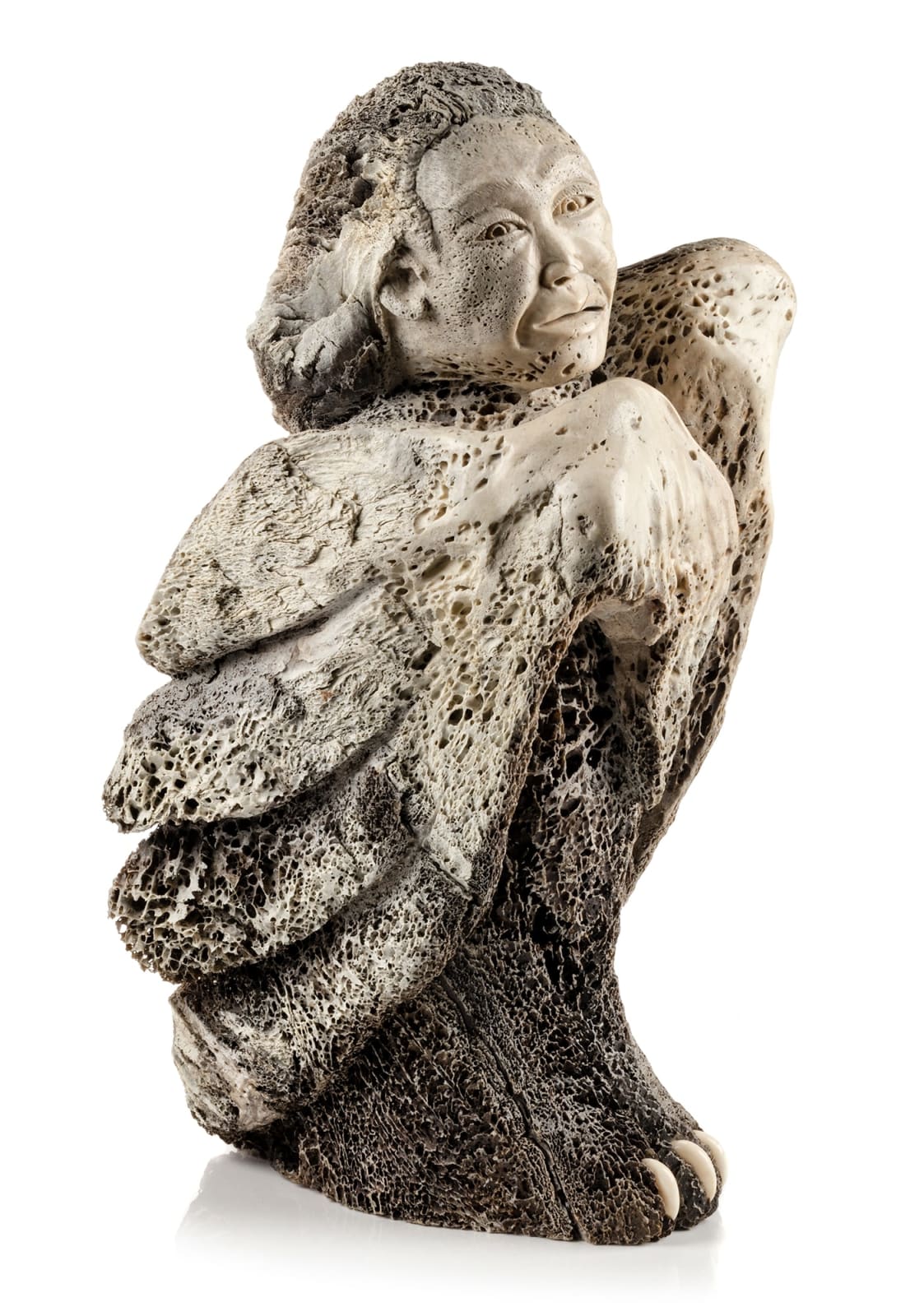-
Artworks
MANASIE AKPALIAPIK (1955-) IKPIARJUK (ARCTIC BAY) / ONTARIO
Bird Shaman, 1990whalebone and ivory, 18.75 x 6.75 x 12.5 in (47.6 x 17.1 x 31.8 cm)
unsigned.LOT 15
ESTIMATE: $12,000 — $18,000
PRICE REALIZED: $29,280.00Further images
After a restless and rebellious youth, during which time he occasionally carved, Manasie married and started a family, only to have his life turned upside down when his wife and...After a restless and rebellious youth, during which time he occasionally carved, Manasie married and started a family, only to have his life turned upside down when his wife and children died tragically in a fire around 1980. He moved from Arctic Bay to Montreal and began carving professionally, learning from artist-friends in that city. After a brief stint back home in Arctic Bay in 1985 he moved to Toronto and began to carve feverishly, encouraged by the gallerist Harold Seidelman. Bird Shaman is one of a group of remarkable sculptures carved in preparation for an important solo exhibition of some fifty works organized by Darlene Wight at the Winnipeg Art Gallery in 1990.
In his essay reviewing the Winnipeg Art Gallery solo exhibition of Manasie’s sculpture in the Spring 1991 issue of IAQ, George Swinton insisted that Manasie be discussed as a sculptor first, one who “just happened” to be an Inuk. He wanted us to appreciate Manasie’s art through its “visual form” rather than its “verbal content.” [1] It could be argued that Manasie Akpaliapik captured the essence of Karoo Ashevak’s spirit with his own modernist vision, his inventive use of whale bone, and his brilliant technical skill (see Lot 39), even though Manasie’s personal style is quite different: his figures and faces are naturalistically rendered, and he carves bone as a monolithic material rather than “constructing” figures. [2]
While many of Akpaliapik’s sculptures are dramatic and exhibit a high degree of emotional or psychological tension [3], Bird Shaman exemplifies the softer, more serene current that runs through much of his oeuvre. The figure’s face is exquisitely lovely, and even the forms of the more roughly textured, porous bone feel gentle rather than raw. In contemplating this masterpiece, we come back to Swinton’s thoughts. It really matters not whether the figure is male or female, shaman or other human or spirit, carved by an Inuk or not. It is an extraordinary and profound work of art, created by a brilliant and sensitive sculptor of the first order.
1. George Swinton, “The Art of Manasie Akpaliapik: A Review Essay” in Inuit Art Quarterly (Spring 1991:42-45).
2. In her 1990 catalogue Darlene Wight points out that Manasie is an admirer of the whale bone sculpture of Davie Atchealak.
3. See First Arts, 13 July 2021, Lot 7; and Ingo Hessel, Inuit Art: An Introduction (1998), plates 56 and 109.Provenance
Images Art Gallery, Toronto;
Acquired from the above by the present Private Collection, Toronto.
Exhibitions
Winnipeg, Winnipeg Art Gallery, Manasie: The Art of Manasie Akpaliapik, 1990, cat. 49.
Verona, Italy, Galleria d’Arte Moderna e Contemporanea di Palazzo Forti, Immaginario Inuit: Arte e Cultura degli Esquimesi Canadesi, 19 March – 9 July 1995; catalogue 107, p. 188, as Double Vision.Publications
Darlene Wight, Manasie: The Art of Manasie Akpaliapik, (Winnipeg: Winnipeg Art Gallery), 1990, cat. 49, fig. 5.Palazzo Forti, Immaginario Inuit: Arte e Cultura degli Esquimesi Canadesi, Galleria d’Arte Moderna e Contemporanea di Palazzo Forti, (Palazzo Fort: Verona, Italy, 1995), cat. 107, p. 188, as Double Vision;
Harold Seidelman & James Turner, The Inuit Imagination: Arctic Myth and Sculpture, (Vancouver: Douglas & McIntyre Ltd., 1993), fig. 19, p. 45, as Double Vision.
Join our mailing list
* denotes required fields
We will process the personal data you have supplied in accordance with our privacy policy (available on request). You can unsubscribe or change your preferences at any time by clicking the link in our emails.














